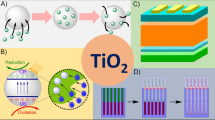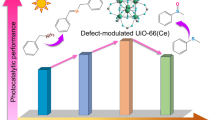Abstract
Photocatalytic oxidation is used for air purification from low concentrations of organic compounds and microbiological objects. Adsorption is the first stage of photocatalytic oxidation, and adsorption constant value has direct linear influence onto the rate of oxidation at low concentration according to the Langmuir-Hinshelwood equation. The present computational investigation has been undertaken with the goal to estimate the effect of nanoparticle size in the range of 1–1.5 nm, extent of hydroxylation, surface acidity, and nanoparticle shape on adsorption of acetone over TiO2 anatase particle facets, edges, and vertices. The anatase nanoparticles were represented by three cluster models—two of cubic shape and one of decahedral shape with exposed surfaces (001), (100), and (101). Adsorption energy was calculated with density functional tight binding (DFTB) semiempirical method and varied from − 0.67 to − 25.79 kcal/mol for different sites of the clusters depending on facet types and location on a facet. Mean unweighted adsorption energy of acetone increased from − 4.49 to − 8.16 kcal/mol for (001) facet and from − 11.05 to − 12.97 kcal/mol for (100) facet when the cubic cluster size increased from 3 × 3 × 1 to 4 × 4 × 1 elementary cells. For decahedral cluster, mean adsorption energy on (001) facet was − 9.87 kcal/mol and − 14.44 kcal/mol on (101) facets. The largest adsorption energy − 25.60 and − 25.79 kcal/mol was observed on grove Ti atoms on (100) facet of the largest cubic cluster and vertex atoms in decahedral cluster, respectively. Dissociative adsorption of one and two water molecules on (001) facet increased acetone adsorption energy from − 4.02 to − 8.20 and to − 18.50 kcal/mol. A marked electronic effect on adsorption energy was observed for two adjacent sites on (001) facet with a similar structure but adsorption energy − 16.40 and − 1.40 kcal/mol. Influence of acetone adsorption on clusters’ band gap, photogenerated thermalized electron and hole location, and C=O vibration wavenumber is also reported.










Similar content being viewed by others
References
Aradi B, Hourahine B, Frauenheim T (2007) DFTB+, a sparse matrix-based implementation of the DFTB method †. J Phys Chem A 111:5678–5684. https://doi.org/10.1021/jp070186p
Bavykin DV, Dubovitskaya VP, Vorontsov AV, Parmon VN (2007) Effect of TiOSO 4 hydrothermal hydrolysis conditions on TiO 2 morphology and gas-phase oxidative activity. Res Chem Intermed 33:449–464
Bianchi CL, Gatto S, Pirola C et al (2014) Photocatalytic degradation of acetone, acetaldehyde and toluene in gas-phase: comparison between nano and micro-sized TiO2. Appl Catal B Environ 146:123–130. https://doi.org/10.1016/j.apcatb.2013.02.047
Carp O (2004) Photoinduced reactivity of titanium dioxide. Prog Solid State Chem 32:33–177. https://doi.org/10.1016/j.progsolidstchem.2004.08.001
Chen X, Mao SS (2007) Titanium dioxide nanomaterials: synthesis, properties, modifications, and applications. Chem Rev 107:2891–2959. https://doi.org/10.1021/cr0500535
Deng X, Yue Y, Gao Z (2002) Gas-phase photo-oxidation of organic compounds over nanosized TiO 2 photocatalysts by various preparations. Appl Catal B Environ 39:135–147
Dolgonos G, Aradi B, Moreira NH, Frauenheim T (2010) An improved self-consistent-charge density-functional tight-binding (SCC-DFTB) set of parameters for simulation of bulk and molecular systems involving titanium. J Chem Theory Comput 6:266–278. https://doi.org/10.1021/ct900422c
Elstner M, Porezag D, Jungnickel G et al (1998) Self-consistent-charge density-functional tight-binding method for simulations of complex materials properties. Phys Rev B 58:7260–7268. https://doi.org/10.1103/PhysRevB.58.7260
Freitag J, Domínguez A, Niehaus TA et al (2015) Nitrogen(II) Oxide Charge Transfer Complexes on TiO 2 : A New Source for Visible-Light Activity. J Phys Chem C 119:4488–4501. https://doi.org/10.1021/jp5108069
Henderson MA (2005) Photooxidation of acetone on TiO 2 (110): conversion to acetate via methyl radical ejection. J Phys Chem B 109:12062–12070. https://doi.org/10.1021/jp0507546
Jimmy CY, Yu J, Zhang L, Ho W (2002) Enhancing effects of water content and ultrasonic irradiation on the photocatalytic activity of nano-sized TiO 2 powders. J Photochem Photobiol Chem 148:263–271
Kapilashrami M, Zhang Y, Liu Y-S et al (2014) Probing the optical property and electronic structure of TiO 2 nanomaterials for renewable energy applications. Chem Rev 114:9662–9707. https://doi.org/10.1021/cr5000893
Linsebigler AL, Lu G, Yates JT (1995) Photocatalysis on TiO2 surfaces: principles, mechanisms, and selected results. Chem Rev 95:735–758. https://doi.org/10.1021/cr00035a013
Luévano-Hipólito E, de la Cruz AM (2016) Enhancement of photocatalytic properties of TiO2 for NO photo-oxidation by optimized sol–gel synthesis. Res Chem Intermed 42:7065–7084. https://doi.org/10.1007/s11164-016-2518-7
Macwan DP, Dave PN, Chaturvedi S (2011) A review on nano-TiO2 sol–gel type syntheses and its applications. J Mater Sci 46:3669–3686. https://doi.org/10.1007/s10853-011-5378-y
Mattioli G, Amore Bonapasta A, Bovi D, Giannozzi P (2014) Photocatalytic and photovoltaic properties of TiO 2 nanoparticles investigated by ab initio simulations. J Phys Chem C 118:29928–29942. https://doi.org/10.1021/jp509830w
Monticone S, Tufeu R, Kanaev A et al (2000) Quantum size effect in TiO2 nanoparticles: does it exist? Appl Surf Sci 162–163:565–570. https://doi.org/10.1016/S0169-4332(00)00251-8
Nunzi F, Storchi L, Manca M et al (2014) Shape and morphology effects on the electronic structure of TiO 2 nanostructures: from nanocrystals to Nanorods. ACS Appl Mater Interfaces 6:2471–2478. https://doi.org/10.1021/am404293x
Pastore M, De Angelis F (2015) First-principles modeling of a dye-sensitized TiO 2 /IrO 2 Photoanode for water oxidation. J Am Chem Soc 137:5798–5809. https://doi.org/10.1021/jacs.5b02128
Paz Y (2010) Application of TiO2 photocatalysis for air treatment: patents’ overview. Appl Catal B Environ 99:448–460. https://doi.org/10.1016/j.apcatb.2010.05.011
Persson P, Bergström R, Lunell S (2000) Quantum chemical study of Photoinjection processes in dye-sensitized TiO 2 nanoparticles. J Phys Chem B 104:10348–10351. https://doi.org/10.1021/jp002550p
Prezhdo OV (2009) Photoinduced dynamics in semiconductor quantum dots: insights from time-domain ab Initio studies. Acc Chem Res 42:2005–2016. https://doi.org/10.1021/ar900157s
Satoh N, Nakashima T, Kamikura K, Yamamoto K (2008) Quantum size effect in TiO2 nanoparticles prepared by finely controlled metal assembly on dendrimer templates. Nat Nanotechnol 3:106–111. https://doi.org/10.1038/nnano.2008.2
Singhal N, Ali A, Vorontsov A et al (2016) Efficient approach for simultaneous CO and H2 production via photoreduction of CO2 with water over copper nanoparticles loaded TiO2. Appl Catal A Gen 523:107–117. https://doi.org/10.1016/j.apcata.2016.05.027
Stewart JJP (2007) Optimization of parameters for semiempirical methods V: modification of NDDO approximations and application to 70 elements. J Mol Model 13:1173–1213. https://doi.org/10.1007/s00894-007-0233-4
Vega-Arroyo M, LeBreton PR, Zapol P et al (2007) Quantum chemical study of TiO2/dopamine-DNA triads. Chem Phys 339:164–172. https://doi.org/10.1016/j.chemphys.2007.06.037
Vorontsov A (2000) Kinetics of the photocatalytic oxidation of gaseous acetone over platinized titanium dioxide. J Catal 189:360–369. https://doi.org/10.1006/jcat.1999.2717
Vorontsov AV (2015a) Molecular and dissociative adsorption of a diethylsulfide molecule on (010) and (001) faces of a TiO2 anatase nanoparticle. J Struct Chem 56:813–822. https://doi.org/10.1134/S0022476615050017
Vorontsov AV (2015b) Cluster models of photocatalytic anatase TiO2 nanoparticles and their computational characterization. Catal Today 252:168–176. https://doi.org/10.1016/j.cattod.2014.10.017
Vorontsov AV, Tsydenov DE (2014) Arrangement of acid sites on the surfaces of anatase titanium dioxide nanoparticles according to cluster models. Kinet Catal 55:409–415. https://doi.org/10.1134/S0023158414040156
Vorontsov AV, Altynnikov AA, Savinov EN, Kurkin EN (2001) Correlation of TiO 2 photocatalytic activity and diffuse reflectance spectra. J Photochem Photobiol Chem 144:193–196
Wanbayor R, Ruangpornvisuti V (2010) Adsorption of di-, tri- and polyatomic gases on the anatase TiO2 (001) and (101) surfaces and their adsorption abilities. J Mol Struct-Theochem 952:103–108. https://doi.org/10.1016/j.theochem.2010.04.032
Wu N, Wang J, Tafen DN et al (2010) Shape-enhanced photocatalytic activity of single-crystalline Anatase TiO 2 (101) Nanobelts. J Am Chem Soc 132:6679–6685. https://doi.org/10.1021/ja909456f
Xiang Q, Lv K, Yu J (2010) Pivotal role of fluorine in enhanced photocatalytic activity of anatase TiO2 nanosheets with dominant (001) facets for the photocatalytic degradation of acetone in air. Appl Catal B Environ 96:557–564. https://doi.org/10.1016/j.apcatb.2010.03.020
Xu W, Raftery D (2001) In situ solid-state nuclear magnetic resonance studies of acetone photocatalytic oxidation on titanium oxide surfaces. J Catal 204:110–117. https://doi.org/10.1006/jcat.2001.3380
Zhang L, Mohamed HH, Dillert R, Bahnemann D (2012) Kinetics and mechanisms of charge transfer processes in photocatalytic systems: a review. J Photochem Photobiol C Photochem Rev 13:263–276. https://doi.org/10.1016/j.jphotochemrev.2012.07.002
Zhao X, Jin W, Cai J et al (2011) Shape- and size-controlled synthesis of uniform Anatase TiO2 Nanocuboids enclosed by active {100} and {001} facets. Adv Funct Mater 21:3554–3563. https://doi.org/10.1002/adfm.201100629
Acknowledgements
This work was supported by Russian Foundation for Basic Research projects 13-08-01286 and 15-08-01936.
Funding
This study was funded by Russian Foundation for Basic Research (grant numbers 13–08-01286 and 15–08-01936).
Author information
Authors and Affiliations
Corresponding author
Ethics declarations
Conflict of interest
The author declares that there is no conflict of interest.
Rights and permissions
About this article
Cite this article
Vorontsov, A.V. Structural and electronic effects in acetone adsorption over TiO2 anatase clusters as the first stage of photocatalytic oxidation. J Nanopart Res 19, 326 (2017). https://doi.org/10.1007/s11051-017-4025-1
Received:
Accepted:
Published:
DOI: https://doi.org/10.1007/s11051-017-4025-1




